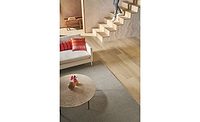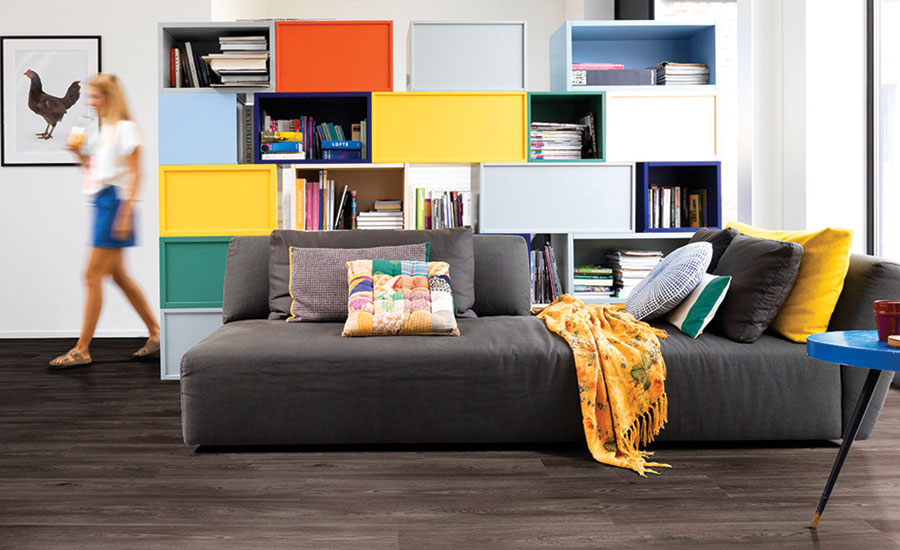A Closer Look at Retailing Green

Manufacturers like Beauflor are speaking to consumers’ concerns about air pollution by developing technology for the reduction of VOC emissions.


Manufacturers are charged with meeting the performance and sustainability expectations of users. An example is Shannon Specialty Floors’ Tuf Stuf Think Ahead luxury vinyl tile and plank line made of 100% virgin PVC vinyl, non-phthalate plasticizers and is free of heavy metals.



As consumers push for more environmentally friendly products across all markets and industries, flooring manufacturers and retailers are developing and selling more sustainable products to meet this “green” demand—without compromising the look, integrity and durability that end-users continue to seek in flooring.
Article Index:
What ‘Green’ Really Means
“As green terminology is becoming more mainstream, the demand for green products is definitely growing,” said Nicolette Grieco, vice president of sales for Shannon Specialty Floors.
“Green” in terms of flooring is flooring produced from sustainable materials by a sustainable process that reduces its environmental footprint. Current eco-friendly products range from cork and bamboo to rubber, linoleum and reclaimed hardwood, and environmentally conscious consumers are turning to these and other green flooring options for a variety of commercial and residential applications.
“More environmentally friendly flooring options are in high demand for both residential and commercial applications,” said Renee Henze, global marketing manager of DuPont Sorona and Biomaterials. “Commercial users are often looking for a way to contribute toward LEED certification and using eco-conscious flooring, such as carpets made with Sorona, can help achieve that goal. Homeowners and residential users are interested in making a sustainable purchase that will not only reach their performance expectations, but also give them the design flexibility to meet their aesthetic desires.”
Whether it is at the beginning or end of a product’s lifespan, consumers are typically seeking flooring that has been, or can be, recycled.
“Recycling is the most common question that people want to know; if we are recycling their existing flooring, or if the new flooring will be able to be recycled when the life expectancy has expired,” said Carlton Billingsley of Floors and More in Benton, Ark., and chairman of Starnet’s Environmental Issues Committee. “More clients also are beginning to question the recycled content of products and the labels of certification that the product meets certain criteria.”
However, green flooring does not just mean recycled flooring, said Sheri Gorman of R.D. Weis Cos. in New York, and chairman of Starnet’s Specifiers Committee. “End-users always ask for recycled content because that was the first thing done to products. To the average end-user, that is all they know. There are so many other aspects that go into making a product green.”
While certain aspects that go into making a product green vary based on the material, some are universal and consistent across the board. These include, but are not limited to, how a product was manufactured and its chemistry makeup.
“Many of our clients are concerned with the manufacturing process of type of product segment, chemistry makeup of product, process of manufacturer and lifecycle expectancy,” said Billingsley.
Consumers concerned about indoor air quality are also seeking green flooring that contains few to no volatile organic compounds (VOCs).
“I’m encouraged that customers are asking about the VOCs coming from products,” said Judith Huck, owner of Classique Floors in Portland, Ore. “If they ask us, we’re asking our vendors and that encourages our vendors to make it easier to find low-VOC products, they’ll be labeled better; we need a standardized rating system to be able to compare products.”
In terms of green flooring, transparency is key and being achieved with the help of product labels and third-party certifications.
“There is a greater emphasis on transparency throughout the A&D community,” said Tiffany Davis, Shannon Specialty Floors’ marketing director. “Designers and specifiers are looking to source products from manufactures that show proof of being Red List free. This is done through third-party certifications, such as Health Product Declarations (HPD’s), Environmental Product Declarations (EPD’s), Declare and Cradle-to-Cradle Certified. All of these certifications ensure the product make-up is safe for use in commercial environments and contribute to meeting LEED requirements.”
Retailing Green
For retailers, transparency is also an important factor when it comes to selling sustainable flooring, according to Billingsley.
“Be transparent and willing to do the right thing even when no one is looking; clients can see if you are trying to bluff your way for a sell,” he said. “No one has all the answers and you have to continue to ask questions. Fortunately, Starnet has an Environmental Issues committee that invites our vendor partners to join our monthly conference calls so we can learn from them what they’re doing and how we can continue to work together and [discuss] within our membership challenges/issues we are facing in our respective markets.”
On the showroom floor, salespeople need to be knowledgeable and prepared to answer questions from the environmentally conscious and well-informed consumer. Common questions today’s consumers are asking, according to Grieco, include: What certification does the product have? How many LEED points does it contribute? Is it polyvinyl chloride (PVC) free? Is it low maintenance? Where is the product manufactured?
“Retailers should become more educated on the products they are offering to their clients and the overall consequences of those items to the environment long term,” Grieco added. “The quick cheap answer is not always the right one. Life-cycle cost and ROI should be brought into consideration.”
Highlighting manufacturers with top FloorScore labels and focusing consumer’s attention on the green aspects of all their product lines is one small change retailers can make to educate consumers, according to Eric Ericskson, the vice president of marketing at Beauflor. FloorScore is an indoor air quality (IAQ) certification standard for hard surface flooring materials, adhesives, and underlayments.
“Along with wanting to utilize recyclable materials, customers are also concerned with indoor air pollution,” Erikson said.
As with any flooring purchase, consumers are making an investment and questions about the cost and maintenance of sustainable flooring are typically at the top of their lists.
“Care and maintenance are always major concerns along with lifecycle costs,” Davis said. End-users want to ensure the product will hold up to the traffic the environment is susceptible too, so they will request information around the life cycle costs of the product being specified.”
For the team at Floors and More, introducing consumers to eco-friendly products to aid in the cleaning and maintenance of their sustainable flooring is an important part of the sale.
“Cleanability and appearance always is either asked by the clients or discussed by our salespeople [and] explaining the maintenance of flooring is part of the process as well,” Billingsley said. “ We go through products for maintenance that are green by their chemistry makeup, less is more in chemical solution, less use of water, etc. so the client understands that not only is the product better for the environment, but the application to keep it looking great longer is too.”
But being a green retailer means much more than just selling sustainable flooring and eco-friendly maintenance products, according to the retailers and manufacturers we spoke to.
“To truly be a green retailer involves more than just selling a sustainable product,” Henze said. “It’s about running a sustainable business and incorporating that type of thinking into every facet of the business. Companies that adopt and adhere to eco-efficient processes and protocols—from the ideation to production to delivery of a product—are truly focused on reducing their impact on the environment. For example, by promoting more durable carpets with timeless color and style, instead of replacing them every three to five years, retailers are helping to reduce waste and progress sustainability initiatives.”
Gorman added, “I think there are so many things companies to be to be green. From how they run their offices, less paper, less electricity, fuel efficient vehicles, greener methods of installation and of maintenance and recycling—and of course, promoting green products.”
The Future of Green Flooring
“The future of green floors lies in more universal adoption, Henze said. “As the realities of environmental consequences become more widely acknowledged, shoppers at the commercial and residential levels are looking to increase their green purchases. Manufacturers are charged with realizing the performance and sustainability expectations of users, while simultaneously reducing their own environmental footprint.”
According to Gorman, sustainable flooring is much more than just a fad and is here to stay. “I have been saying for some time now, it will just become the way it is,” she said. “I believe that is starting to happen. All manufacturers are taking sustainability into account, from manufacturing to recycling and everything in between. Every product has its own green story.”
Looking for a reprint of this article?
From high-res PDFs to custom plaques, order your copy today!












